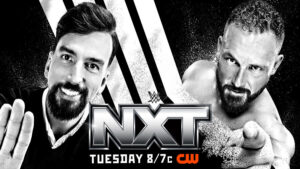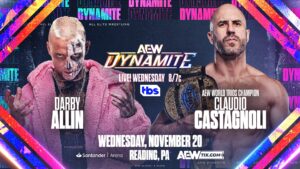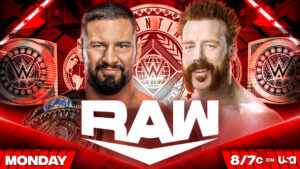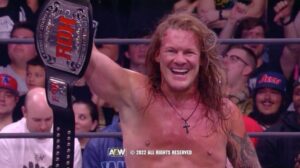When one contemplates it, what is really needed for a wrestling show? Obviously wrestlers, but cameras, chairs, even fans have been proven optional. For every multimillion dollar gate that WWE or AEW bring in, there are plenty of low-end mudshows in abandoned fields or some guy’s mom’s backyard.
What makes wrestling interesting is that there is such a stark contrast from the mainstream brands where talent is seasoned with years on the road and the guidance of backstage staff bankrolled by a publicly-traded conglomerate.
On the other end, small-scale shows offer a chance for budding talent to experiment for a more intimate showing.
There’s always the middle ground too, where independent promotions with connections to the larger companies book talent previously showcased on television. The point of this is to emphasize how wrestling’s mood changes depending on the space it inhabits.
With repetition and success, these spaces become synonymous with their geological location. Regular fans become part of the mythos, being recognized among circles as superfans such as Vladimir Abouzeide of New York City.
As one goes to more shows, their praises or grievances are known as a weekly viewer of The Product. Crowds become just as a part of the show as the set itself, from fan altercations with the talent to verbal abuse, sometimes profane, chants.
With all these in mind, here are some of the most iconic venues in wrestling and the moments that planted them into wrestling mythology.
2300 Arena
South Philadelphia’s 2300 Arena has become engraved in wrestling lore, described by the Northeast Times as a “cult attraction.” Originally used to store freight for the nearby trains, the building was rechristened Viking Hall as a rehearsal space for a local mummers chapter.
Eastern Championship Wrestling began holding shows in the arena in 1993, a budding regional territory run by ex-WCW manager Paul Heyman. Affiliated with the waning National Wrestling Alliance, ECW held a one night tournament for a new world champion.
Newly-crowned NWA Worlds Heavyweight Champion Shane Douglas betrayed the Alliance by desecrating the belt and declaring himself the new ECW World Champion. The organization splintered off as Extreme Championship Wrestling, adopting a smash-mouth presentation in line with the 1990’s zeitgeist.
Beyond the Mat utilized footage of the backstage inner-workings of ECW’s first pay-per-view Barely Legal, including a rousing speech by Paul Heyman to the talent. Other films where the arena has appeared include Rocky Balboa and The Wrestler.
A key aspect of ECW’s crowd was its superfans, who’d stick out for their regular appearances in their “gimmick” such as Straw Hat Guy and Sign Guy.
Moments such as the 1994 Hardcore Heaven chair incident and the Dudleys’ HeatWave 1997 promo captured the passion of a devout fanbase, interacting with the product in a visceral way. In 2001, ECW would cease operations and its assets would be absorbed into the WWE umbrella.
The following year, the Hardcore Hall of Fame was established in the arena after Rocco Rock’s death via heart attack at 49. Rock was traveling to the arena for a show with Pro-Pain Pro Wrestling when his condition worsened, according to The Wrestling Gospel. He is the first admitted into the Hall, with other names including Terry Funk, John Zandig, and most recently, the Dudley Boyz.
Xtreme Pro Wrestling signed an exclusive residency with the arena as it was rechristened the XPW Arena. 3PW and Combat Zone Wrestling were muscled out of running shows at the venue due to the agreement.
This lasted until March 2003, after XPW wrote rubber checks to the building’s management, according to Bob Magee.
Throughout the last two decades, some of the key promotions to run the 2300 Arena include CHIKARA, House of Hardcore, Ring of Honor, TNA/Impact Wrestling, Major League Wrestling, NWA and even a 2006 WWE house show. Former Heyman apostle Gabe Sapolsky ran multiple EVOLVE cards throughout the 2010’s when visiting Philly.
In November 2024, NXT held a special episode from the 2300 Arena. The show tapped into ECW’s nostalgia, featuring cameos from stars such as Rob Van Dam and the Dudleys.
Dawn Marie would make her first appearance in a WWE ring in nearly two decades, serving as guest referee for Lola Vice and Jaida Parker’s hardcore match. Nunzio appeared in a special challenge against North American Champion Tony D’Angelo, the first WWE match he’s had since 2008.
Dallas Sportatorium
Sitting at the crossroads of Industrial Boulevard and Cadiz Street of Dallas, Texas, the Sportatorium became a hotbed of activity every weekend when WCCW held shows there. Promoted by Fritz Von Erich who purchased Big Time Wrestling in the early 1980’s, WCCW became a premiere territory for its cutting edge booking and television production.
Fritz used the company as a vehicle to push his sons into stardom, while showcasing other talents such as Chris Adams and the Fabulous Freebirds.
Aside from the arena setup, the building housed office space for the Von Erichs and WCCW staff to operate the business. As WCCW fell from grace, the Global Wrestling Federation came in to claim the venue as their own in the 1990’s. The Sportatorium was hot-potatoed between local wrestling outfits before it was abandoned in favor of more accommodating spaces.
Failure of maintenance resulted in the building decaying with infestation, squatters, and structural problems. Even in its heyday, the Sportatorium was infamous for its poor amenities such as the sweltering heat and odor.
During an episode of“The Snake Pit” podcast, Jake Roberts recounted an incident where a firearm was discharged during a match. Despite the shock of such a thing happening, Roberts described finishing the match as “the only thing to do.”
In a 2003 report of the venue’s demolition, the Plainview Herald reminisced its glory days. Once a hotbed for the biggest names in pro wrestling and country music, it was reduced to rubble and faded glory.
Heroes of World Class is a 2006 documentary covering the promotion featuring interviews from numerous figures involved in its success. Kevin is shown walking through the ransacked halls of the Sportatorium with a flashlight, reflecting on its better days.
Leading into MLW’s first ever War Chamber match, Kevin brought his sons Ross and Marshall Von Erich to reminisce on the family’s hard work in its prime.
Tokyo Dome
Nicknamed “The Big Egg” for its inflated ovoid roof, the Tokyo Dome opened in March 1988 as a sports and music arena. When looking at promotions who have run the Dome since, it’s a who’s who of wrestling organizations.
NJPW’s Battle Satellite in Tokyo Dome in April 1989 was the first wrestling show promoted at the Dome. The main event saw the USSR’s Shota Chochishvili knockout the company’s founder Antonio Inoki for the WWF World Martial Arts Heavyweight Championship. A one-night tournament for the vacant IWGP Heavyweight Championship was held, seeing Big Van Vader beating Shinya Hashimoto in the finals with Lou Thesz as the guest official.
New Japan hosts annual supercards on January 4th, being far and ahead the venue’s longest tenured pro wrestling guests. The first of these was 1992’s Super Warriors in Tokyo Dome, dually-promoted alongside WCW. In 2007, these shows became known as Wrestle Kingdom where they’d feature some of the greatest wrestling matches of the last decade.
As noted, NJPW has welcomed other promotions in co-hosting shows at the Dome. In a rare act of cooperation between their rival AJPW and the WWF, Wrestling Summit featured Hulk Hogan returning to Japan to defeat Stan Hansen.
The WWF would later run the Dome in a pair of shows alongside Genichiro Tenryu’s Super World of Sports.
Pro Wrestling NOAH’s first Dome show took place in July 2004 for Departure. The final bout of the night saw ex-Burning teammates Jun Akiyama and defending GHC Champion Kenta Kobashi square off in a rematch four years in the making.
A year later, NOAH returned with Destiny. That show would close with eternal rivals Mitsuharu Misawa and Toshiaki Kawada crossing paths for the first time since AJPW’s summer 2000 exodus.
Dramatic Dream Team’s Street Wrestling saw NEVER Openweight Champion Minoru Suzuki face Sanshiro Takagi in a non-title Empty Arena match. The bout featured cameos from various DDT talent and even Aja Kong, who opened the match with a rendition of Kimigayo.
The Tokyo Dome’s legacy has permeated throughout the wrestling landscape, becoming the country’s premier wrestling venue. Industry greats such as Jushin Thunder Liger and the Great Muta wrestled their retirement matches at Tokyo Dome events. Even in the west, Dave Meltzer’s preference over puroresu has led to jokes about inflating a match’s star rating if it took place at the Big Egg.
In January 2025, New Japan is to hold Wrestle Kingdom 19. Hiroshi Tanahashi, the man with the most Dome main events under his belt, will be facing EVIL to open his retirement tour.
The following evening, NJPW will be hosting Wrestle Dynasty in a special collaboration with AEW/ROH, CMLL, and Stardom.
WWE ThunderDome
As the COVID-19 Pandemic cast a shadow over the world, mass gatherings such as professional wrestling shows were presented with a conundrum. How does a performance art like wrestling operate without the crowd?
Empty Arena matches had been done as a novelty, but to have that element removed without the say of the WWE meant they needed to adapt. Some shows were held in the Performance Center to mixed results, until August 2020 when the WWE unveiled the ThunderDome.
Kevin Dunn described the goal of the Thunderdome as it sought to create an “immersive atmosphere and generate more excitement,” for viewers at home.
Initially the Thunderdome was housed in the Amway Center in Orlando, but would later move to Tropicana Field and Yuengling Center. Though technically not a specific location, the Thunderdome became the WWE’s way of presenting its television for weekly broadcasts and pay-per-view.
The first PPV at the ThunderDome was the 2020 edition of SummerSlam, which saw the Fiend defeat Universal Champion Braun Strowman in the semi-main event. Following the win, Roman Reigns returned with a new mean streak to begin his ascension as Tribal Chief.
The company’s landscape before and after the ThunderDome made it unrecognizable. The rise of 2021 Royal Rumble winner Bianca Belair, Daniel Bryan’s last WWE match, and Christian’s return to wrestling after career-threatening injuries are only some of the most prominent moments from this era.
To become a member of the virtual audience, one would sign up online and be chosen from a pool of names for free admission. Viewers were able to display their reactions in real time while crowd noises were piped in.
While most fans were cooperative, disruptive users streamed feeds featuring obscene imagery and references to other promotions (h/t Deadspin). To counteract this, the company combed through audience members to ensure their displays didn’t go against the terms of service.
Hell in a Cell in June 2021 would be the last pay-per-view broadcast before the company became a traveling show once again. The ThunderDome was a state-of-the-art experiment in how to present pro wrestling in the face of elements outside the industry’s control.
Other wrestling promotions curbed lockdown restrictions with cinematic matches, outdoor spot shows, and taping in small, unsettlingly intimate spaces. The WWE was able to maintain the air of a blockbuster production with all of the lights, sound, and scale of a typical broadcast with some level of fan interaction, even if they weren’t physically present.
Madison Square Garden
Nestled above Penn Station in Midtown, Manhattan, Madison Square Garden has cultivated a legacy as a hotspot for sports, music, and other entertainment forms. The WWWF found a home in the Garden, with Vince McMahon Sr. keeping the operation afloat. There are claims of Bruno Sammartino allegedly selling out the venue 188 times during his time as the top star of the organization.
As Vince McMahon Jr. pushed for national dominance, they continued to use the space as its home base with monthly WWF on MSG Network television specials.
The inaugural WrestleMania was held at MSG in March 1985, as well as the tenth and twentieth iterations of the flagship event. Aside from WrestleMania, other noteworthy events include the Royal Rumble (2000, 2008), Survivor Series (1996, 2002, 2011), and SummerSlam (1988, 1991, 1998).
Throughout the 2010’s, the WWE scarcely visited MSG, holding house shows primarily with the occasional live broadcast such as the 2015 Live from Madison Square Garden special. On the “Monday Mailbag” podcast, former referee Mike Chioda speculated this being due to costs related to running shows out of the arena (h/t TJR Wrestling).
During this hiatus, other companies stepped in to get their slice into the New York market. Most famously, Ring of Honor and New Japan Pro Wrestling collaborated for the G1 Supercard pay-per-view to great success. Impact Wrestling and AAA held Lucha Invades NY in the Hulu Theater underneath the arena in September 2019.
NJPW was to hold a show at the Garden titled Wrestle Dynasty but the COVID-19 Pandemic killed these plans (h/t Fightful).
Upon returning to a national touring schedule in 2021, WWE announced their return to MSG for September of that year. Since then, WWE reconciled their relationship with the Garden by holding television tapings, including this past June.
More LWOS Pro Wrestling
Header photo – WikiMedia Creative Commons – Stay tuned to the Last Word on Pro Wrestling for more on this and other stories from around the world of wrestling, as they develop. You can always count on LWOPW to be on top of the major news in the wrestling world, as well as to provide you with analysis, previews, videos, interviews, and editorials on the wrestling world.






